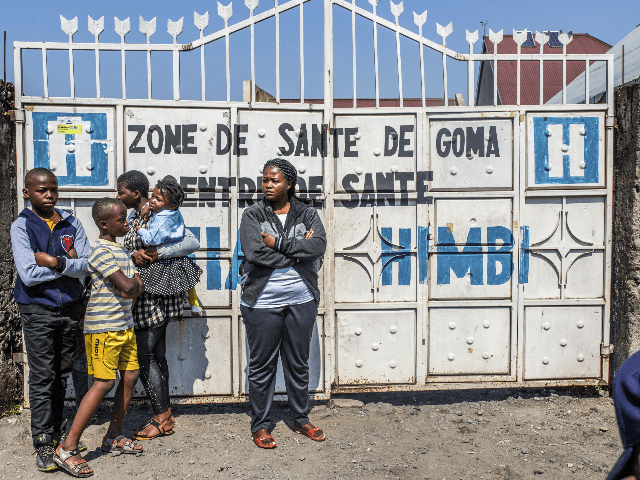A cleric who took a bus 125 miles south within the Democratic Republic of Congo (DRC) tested positive for Ebola upon arriving in Goma, a city of one million on the border with Rwanda, on Sunday.
The latest case, surfacing a significant distance away from the center of the outbreak, has triggered fears that the virus will spread significantly faster now that it has been introduced into a large urban area that serves as a commercial hub for the region. Rwandan officials have begun attempting to track down any potential carriers of the disease to prevent the Ebola outbreak from spreading into the neighboring country. Uganda, which borders Rwanda to the north and DRC to the east, has documented three cases of the virus, but claims to have contained its spread.
DR Congo’s Ministry of Health did not release the suspect’s name, but identified him as a “cleric” who had traveled to the city from Butembo in North Kivu province, the center of the virus outbreak, according to Rwanda’s New Times. The fact that the patient traveled to Goma by bus means he was in a contained space carrying the virus for hours, making it necessary for authorities to track down the other passengers and test them for Ebola.
Ebola virus disease spreads through the blood of an affected person. It is sexually transmitted and contaminates a person through contact with blood, but it is not believed to be spread through minimal contact. Many African communities engage in traditional burial practices that require the families to touch the bodies of dead loved ones, however, and in the process of burying an Ebola victim contract the virus themselves.
Goma is on the southeastern tip of North Kivu province, on Lake Kivu, which it shares with Rwanda. All DRC cases of Ebola during the current outbreak have been contained to North Kivu and Ituri, the province north of it.
Given the proximity to the outbreak’s ground zero, authorities in Goma have spent months preparing for their first patient. Experimental, but largely successful, Ebola vaccines have been administered to health workers who will come in contact with the patients and the government has trained locals on how to prevent the spread of the virus. DRC’s Ministry of Health expressed optimism that Goma would resist the brunt of a full outbreak.
“Due to the speed with which the patient has been identified and isolated, as well as the identification of all passengers from Butembo, the risk of spreading to the rest of the city of Goma remains low,” the ministry said in a statement, according to the New Times.
Doctors Without Borders (MSF), an international aid organization actively working with the Congolese government, issued a statement Monday confirming that the Goma patient had come to one of its facilities to be tested for the virus after showing symptoms. He has left the city, the organization noted, to lower the changes of the virus from spreading within the densely populated area.
“The patient, who travelled from Butembo to Goma, was safely isolated and provided with medical care since his arrival to the center. He has been transferred to Butembo this morning [July 15], as per the Ministry of Health’s decision,” Kate White, MSF’s emergency medical manager, said in a press statement.
World Health Organization (WHO) Director-General Tedros Adhanom Ghebreyesus told United Nations officials on Monday that the Goma case was “very concerning” and a potential “game-changer,” according to Al Jazeera.
“It is a gateway to the region and the world. Although this is a very concerning development, it’s one that we and the government have expected and prepared for,” he said. As many as 3,000 health workers in Goma have received an Ebola vaccine, Ghebreyesus confirmed. Those known to have come in contact with the Goma patient, regardless of health worker status, have also received the vaccine, the WHO said.
The current iteration of the virus was developed in response to the 2014-2016 Ebola outbreak in Guinea, Sierra Leone, and Liberia, the deadliest outbreak to date. That outbreak killed 11,325 people and affected 28,652, including cases in three European countries and the United States. The current one is the second-largest on record after the 2014 outbreak. Current, the WHO has documented 2,477 cases of Ebola and 1,655 deaths.
Health workers attempting to curtail the spread of the disease must contend not only with the speed at which it often spreads due to traditional burial rites, but high levels of distrust in Western medicine among local populations. North Kivu is an active unrest area, not currently in a formal war but home to violent activity by a host of militias, whose members sometimes believe that health workers are deliberately poisoning Africans with Ebola to keep their population low. On Monday, DRC’s Health Ministry confirmed that two medical staffers in eastern North Kivu died in an attack on a medical center after receiving death threats for months.
In May, North Kivu militias killed a prominent virologist working in rural North Kivu as a warning to other doctors and medical staff to stay out of the area. At the time, the WHO had tallied 119 attacks on health workers fighting Ebola since January.

COMMENTS
Please let us know if you're having issues with commenting.